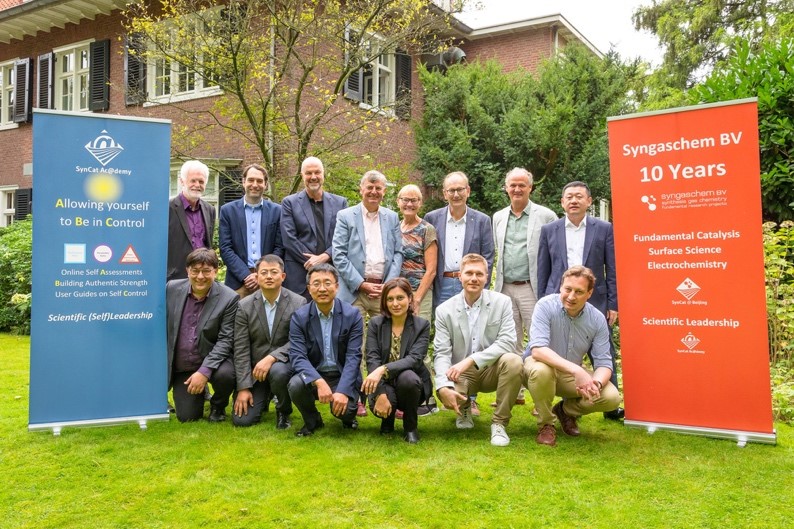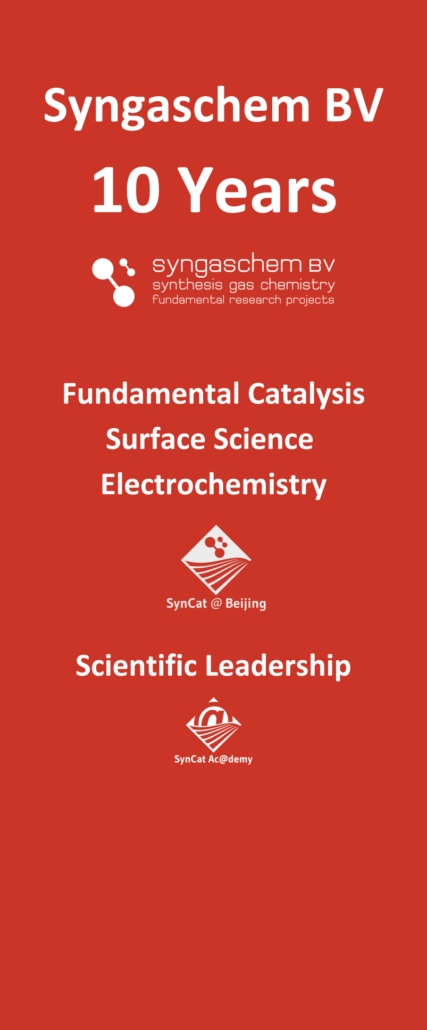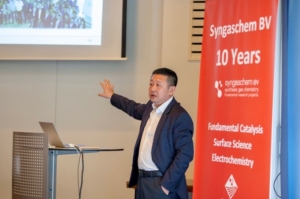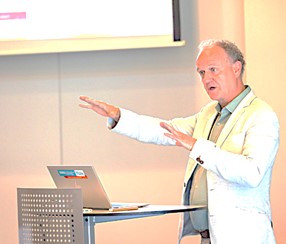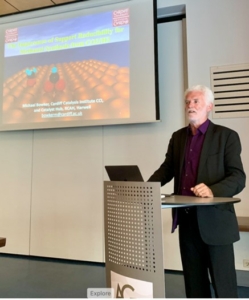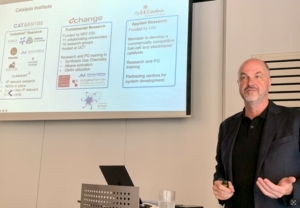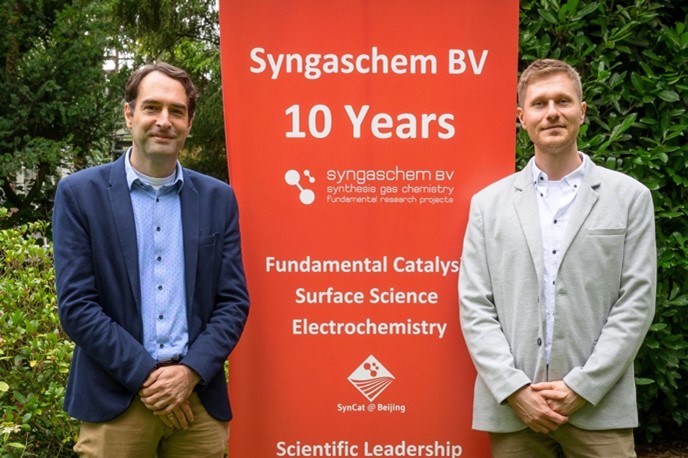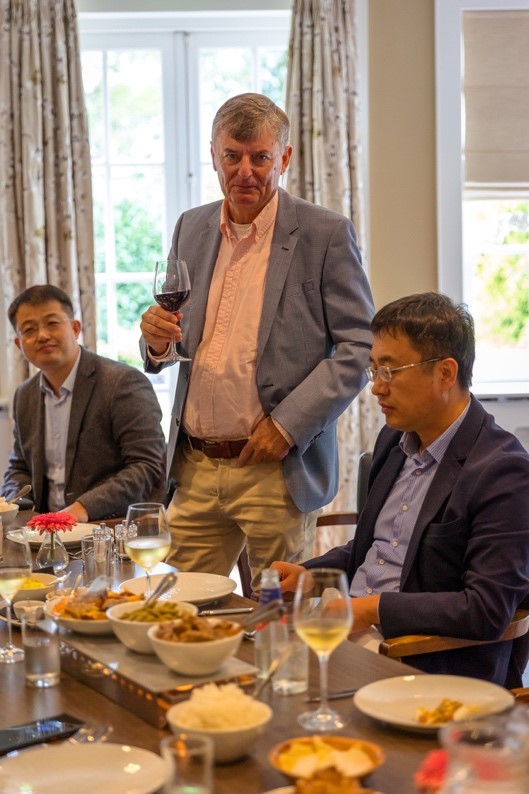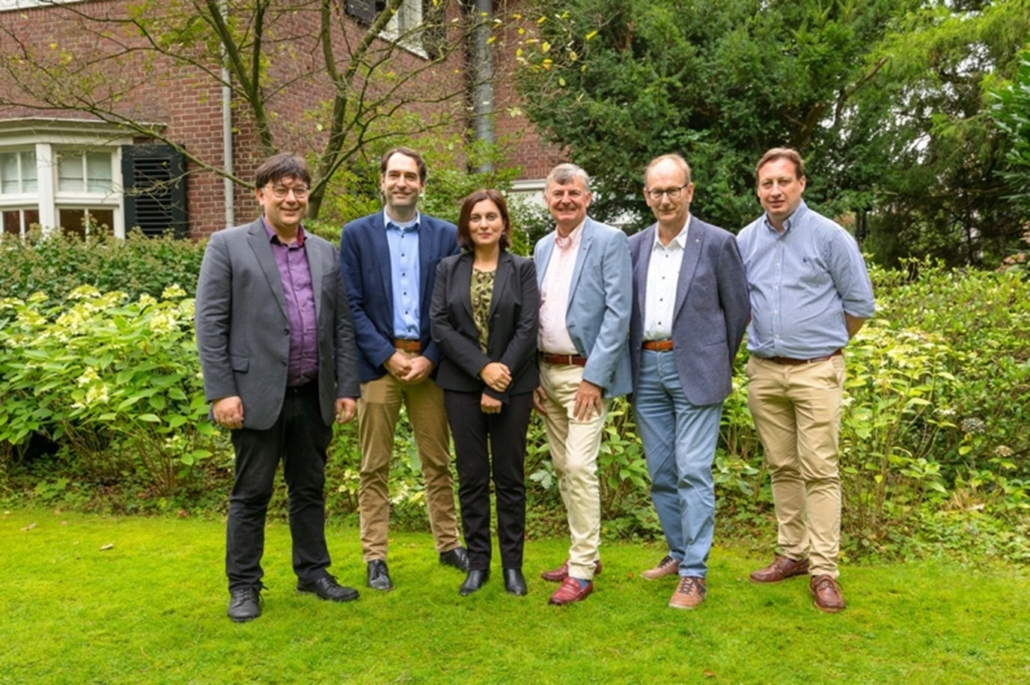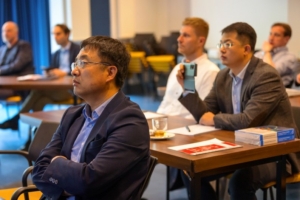Syngaschem BV – 10 Years
Hans Niemantsverdriet opened the meeting with a historic overview. The first contacts between him and Synfuels China date back to April 2012, when Prof Yong-Wang Li and he met for the first time, at the Syngas Convention in Cape Town. Only 10 months later they signed an agreement to build SynCat@Beijing, after which Syngaschem BV was founded, not only to aid in the preparations and recruitment for the new lab in China, but to perform research at Eindhoven as well. Ten years have passed and much has been achieved: SynCat@Beijing and Syngaschem BV have both been quite successful, with a joint scientific production of more than 100 publications, among which are papers in Science, Nature Communications, ACS Catalysis, and many other well-established journals, and, even more important, young scientists who had the chance to grow and develop themselves by doing challenging research projects of their own choice.
All staff members of SynCat@Beijing and Syngaschem BV have had the opportunity to develop their scientific (self) leadership skills as well. Jan Karel Felderhof presented the status of the program, in which the emphasis has shifted to self-leadership, with the emphasis on learning through experience and sailing on one’s inner compass. Jan Karel and Hans intend to prepare a second edition of their 2017 book “Scientific Leadership” which is due to appear in the Fall of 2024.
New FTS Plants by Synfuels China and Plans for Biomass Conversion to Sustainable Air Fuels.
Dr Yang Yong presented an impressive overview of Synfuels China’s Medium Temperature Fischer-Tropsch technology, which has been installed / commissioned at three locations in the past decade: The Shenhua – Ningmei plant of 2016 (100.000 barrels per day, equivalent to 4 Megaton of product per year), and the Yitai – Hangjinqi and Shanxi Luan plants, both in 2017 and both at a capacity of 25.000 b/d (1.0 Mt/a). All three are coal to liquids plants, which is the practical solution for China to produce fuels, chemicals, and natural gas. For the future, Dr Yang foresees a shift in feedstock from coal to biomass and involvement of “e-Hydrogen” (i.e., produced by electrolysis of water with electricity from windmills or solar panels), and in product a larger emphasis on sustainable aviation fuels (SAF). Development of proper refining schemes is essential for delivering SAFs that satisfy the stringent specifications for these fuels. Dr Yang announced a new 100 kiloton (2500 b/d) demo plant for biomass to SAF fuels in 2026, which is of course exciting news.
Future energy systems will be different…
According to Prof Richard van de Sanden, director of the Eindhoven Institute for Renewable Energy Systems of the TU/e, the energy system of the future will be decentralized and much more efficient, with all waste energy being captured and reused. The emphasis will be on electricity, implying end users being industry, households and buildings, as well as transport will have to be electrified where possible. Hard-to-electrify sectors such as the heavy industry, and air and marine transport will be based on a cleaner fuel system that does not generate harmful emissions. Here may be a role for synthetic fuels, but definitely a very important role for hydrogen.
Van de Sanden enthusiastically explains that plasma technology may play an important role in the pyrolysis of methane to generate H2 (“turquois hydrogen”) and ethylene, a process that will be explored further at Chemelot in South Limburg. He foresees that electrolysis will generate a gigantic new industry with enormous opportunities for the manufacturing industries and innovation, but warns for the pitfall of large scale: smaller units that are realized within a few years offer much better scope for gradual improvement than large installations that are built once per 25 years.
Scientific lectures on Methanol and Fischer-Tropsch Synthesis, and Surface Science.
The afternoon programme started off with Mike Bowker, (Cardiff University), entertaining the audience with historic facts on the growing awareness that CO2 is a harmful molecule in the atmosphere. Already Tyndall (1861) and Arrhenius (1896) understood that a Greenhouse Effect due to molecules such as CO2 existed, however, at the time it was not believed that this could have a significant effect on the climate. Callendar in 1938 was the first to show that the Earth’s land temperature had increased over the previous 50 years. He also suggested that CO2 from combustion of fossil fuels was responsible. Mike went on to discuss the conversion of CO2 and H2 to methanol on Pd/ZnO catalysts, where the ZnO plays a critical role to bind the CO2 in the interface with the metal, where it is hydrogenated to formate, and eventually to methanol.
Michael Claeys (University of Cape Town) discussed the stability of iron and cobalt Fischer-Tropsch catalysts, which his team has studied in great detail with in situ techniques, in particular with his well-known magnetometer. With this setup he can also simulate the behavior of catalysts under high conversion conditions to mimick the situation in an industrial reactor. His work on iron catalysts was partially funded by Syngaschem BV and Synfuels China, and has yielded unique insights in the stability of iron with respect to oxidation by water under MTFT conditions.
Richard Gubo treated the audience to high quality STM and XPS work from SynCat@Beijing. He studies well defined models for iron carbides, applied as thin films on a copper metal single crystal. This is a promising approach for getting carbides in a state that experiments by scanning tunneling microscopy are possible. We are eager to see these surfaces used in studies of adsorption and reaction, which will reveal important results on the surface chemistry of these important but experimentally often elusive materials.
Kees-Jan Weststrate presented an overview of his fundamental studies on the mechanism of the Fischer-Tropsch reaction on cobalt, a subject on which he has become a leading expert in the world, with many articles in top journals to vouch for it, and very recently even a perspective article in Science (see elsewhere in the News Section of the website).
Finally, Gilbère Mannie from SPECS Berlin wetted our appetite for state-of-the-art surface science equipment. Indeed, SynCat@Beijing is a loyal customer, and has been using measurements from the SPECS NAP-XPS / STM system for several high-profile publications, as in ACS Catalysis and Science.
The symposium was a great success, not only by the excellent science that was presented by the internationally acclaimed cast of presenters, but also by reuniting good friends who because of the pandemic had not seen each other for some years.
Published on October 11, 2023

